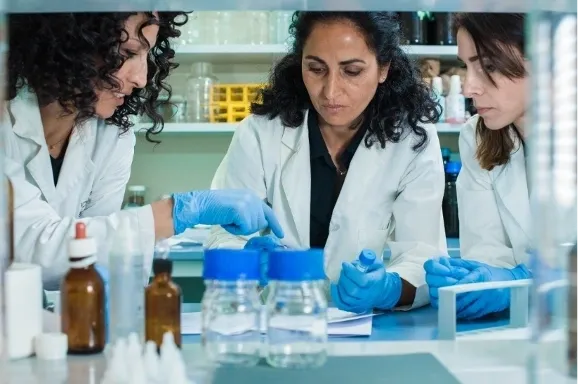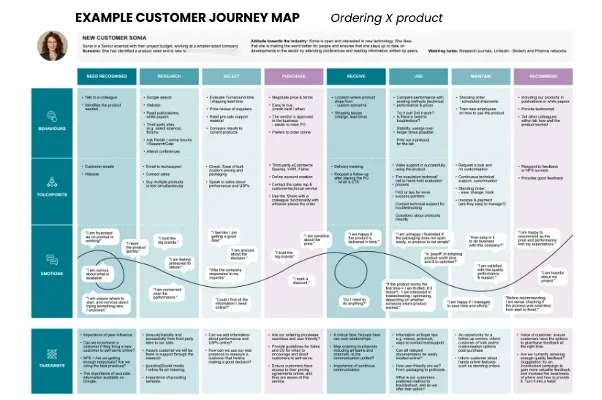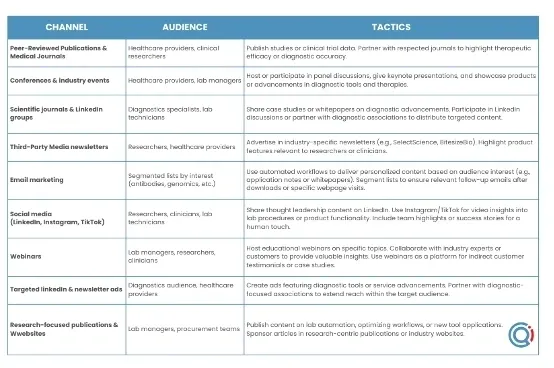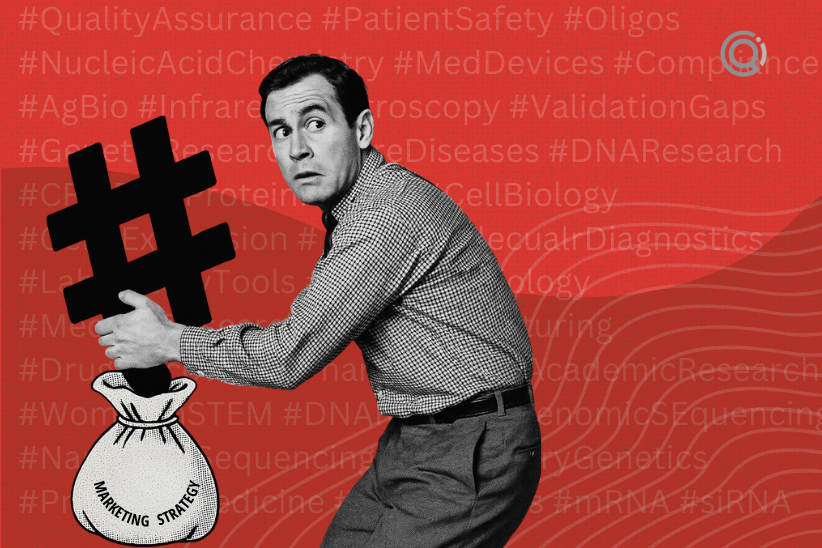Effective lead generation demands more than a single-channel approach in the rapidly evolving Life Sciences industry. Whether developing therapeutics, diagnostics, or other components or services for scientific research, companies must reach and nurture a diverse audience, from healthcare providers to lab researchers, from procurement teams to regulatory bodies. By recognizing that each audience consumes content differently and across various channels, an omnichannel lead generation strategy not only broadens reach but also ensures consistent, personalised engagement.
This article will guide you through building an omnichannel lead strategy that resonates with your audience, improves engagement, and generates qualified leads
The value of omnichannel marketing in Life Sciences
Our ‘Qintastic blog on ‘Addressing common challenges in Life Science funnel conversion’ clearly documents the trials and tribulations faced by marketers working in the Life Sciences space when it comes to attracting and converting leads. But I will remind you that audiences today expect seamless interactions across touchpoints, from professional journals and conferences to social media and email. It falls to marketers to build a successful omnichannel approach that creates a cohesive journey, guiding potential customers from awareness to conversion while ensuring a consistent brand experience.
Omnichannel marketing is particularly valuable for Life Sciences because it allows for segmented communication, precision targeting, and better data-driven decision-making. This is essential in an industry where there are traditionally long sales cycles and where potential customers often need substantial information and reassurance before making purchasing decisions, especially when products can affect research outcomes or patient care.
So, now that we’ve established why it’s important to develop an omnichannel strategy let’s look at how to create one, step-by-step.
Step 1: Define your audience segments and objectives
Start by understanding your audience. Life Sciences companies often serve varied segments, including:
- Clinical researchers and lab managers interested in diagnostics or lab equipment.

- Procurement teams looking for cost-effective research solutions.
- Clinicians and healthcare providers who require data-backed products, particularly in diagnostics or therapeutics.
- Business partners and collaborators such as other biotech companies or research institutions wanting to collaborate on R&D projects.
For each audience, define clear objectives. For example, a diagnostics company may want to increase leads for testing kits by targeting lab managers with information on accuracy and turnaround time, while a therapeutics company might aim to increase clinical trial enrolments by targeting healthcare providers. Understanding these objectives helps you to create a tailored journey for each of your prospective customers that moves them closer to conversion.
Step 2: Map the customer journey

The stakes are higher in Life Sciences because of regulatory and compliance requirements and the potential impact on patient safety and health outcomes. This means that, unlike consumer products, the buying journey is often long and highly involved. Mapping out this journey helps in identifying which channels, content and content formats are most effective at each stage. If it helps to physically draw out your funnel, do so and then document what content you have or need against each part of the funnel in the following way:
- Awareness: At this stage, prospects may encounter your brand through scientific publications, industry conferences, or social media. To capture that initial interest, you could consider using paid ads in industry journals or third-party media newsletters, social posts that highlight key research, or thought-leadership editorials, either featuring a customer or an internal subject-matter expert. For a more detailed overview of tactics that can be employed at this part of the funnel read Part 1 of another ‘Qintastic blog on ‘Evaluating and optimising your funnel’

- Consideration: Once prospects are aware of your product or service, they often need more detailed information to make an informed decision. As scientists, they’ll be interested in the data and research supporting the performance of your product or service. Webinars, application notes, or technical articles can be effective, offering deeper insights into how your product or service benefits their research or clinical needs. You can read Part 2 of our blog, dealing with this part of the funnel here.
- Decision: At this stage, prospects are evaluating your product against competitors. The bottom of the funnel is where marketers have to deliver that final experience that convinces them that your product is the right choice, removing the final barriers to purchase. Case studies, ROI calculators, product demos, and trials can help address specific pain points and support final decision-making. And Part 3 of our blog can be accessed here.
Mapping these steps allows you to deliver relevant content at the right time, guiding leads naturally through the funnel while positioning your brand as a trusted resource.
Step 3: Choose the right channels and tactics
To build an effective omnichannel marketing experience, you need to select channels based on your target audience and the type of product that is being marketed. Here are a few ways you could think about different channels and tactics for specific segments within Life Sciences:
- Therapeutics: Engaging with healthcare providers and clinical researchers requires a focus on credible sources. Leverage peer-reviewed publications, partnerships with respected medical journals, and conference presentations to reach this audience. Email newsletters containing updates on clinical trial data or regulatory news also work well in keeping them informed.
- Diagnostics: For those in diagnostics, scientific journals, LinkedIn, and healthcare webinars are highly relevant. Several third-party media companies like SelectScience, BitesizeBio, AZONetwork and ResearchGate offer targeted newsletters featuring the most recent developments in this area. These channels allow you to reach an audience interested in the latest advancements in testing methodologies and diagnostic tools. Use targeted LinkedIn or newsletter ads or partnerships with diagnostic associations to extend your reach.
- Tools and services: Social platforms like LinkedIn and ResearchGate, email marketing, and industry-specific websites help in targeting researchers, and lab technicians and managers. Consider regularly posting updates on LinkedIn about advancements in lab automation or optimising workflows, hosting educational webinars with industry-specific media companies, or sponsoring articles in research-focused publications.
Tactics by channel
- Email marketing: Segment lists by interests (e.g., antibodies, genomics) and nurture each segment with content like whitepapers, case studies, or research updates. For instance, if a lead downloads a research paper on your sequencing platform, follow up with a series of emails showcasing relevant application notes and other relevant content.
- Social media: Use LinkedIn for promoting thought leadership and consider platforms like Instagram or TikTok for video content. Scientific posts, behind-the-scenes insights into your R&D, or team highlights add a human element that appeals to researchers and practitioners alike.

- Webinars: Webinars are a powerful tactic in Life Sciences, as they provide an interactive space for prospects to engage with your team. Consider hosting topic-specific webinars or collaborating with customers or industry experts, focusing on current research and practical applications of your technology. Getting customers to present how they have used your products is a wonderful way to get indirect customer testimonials and can be very effective, particularly if what they’re doing is novel or ground-breaking.

Step 4: Leverage data for personalization and targeting
Data is critical to creating a personalised experience in Life Sciences. Collect insights on customer interactions (e.g., website visits, email opens, social engagement, number of touchpoints per customer or prospect) so you can develop targeted campaigns that resonate with each segment’s unique needs.
Using data for targeted outreach:
- Personalized content recommendations: Tailor content based on the audience’s past behaviour. If a prospect frequently engages with articles on molecular diagnostics, follow up with relevant application notes or case studies.
- Audience segmentation: Use CRM and analytics tools to segment leads based on their interactions and interests. For example, create a segment for next-generation sequencing researchers who have shown interest in new library preparation or quality control methods, allowing you to serve them content that sits directly in their field.
This approach helps create a seamless journey where prospects receive content that feels relevant and valuable, increasing the likelihood of conversion.
Step 5: Integrate AI and automation for efficiency and scalability
For Life Science companies with a diverse prospect base, AI and automation can make omnichannel marketing more efficient and scalable. There are AI tools that help analyze large volumes of data, revealing patterns in customer behaviour that might otherwise go unnoticed. Automation will help to ensure timely engagement.
Practical applications of AI and automation:
- Automated email sequences: Set up nurture campaigns triggered by actions such as webinar attendance, eBook downloads, or specific webpage visits. This allows you to nurture those leads and ensures that they receive timely, relevant content without manual intervention.

- Predictive analytics: There are predictive analytics tools out there that use AI to predict which leads are most likely to convert based on past behaviour. This allows your sales team to focus efforts on high-potential leads, improving both efficiency and outcomes.
- AI-driven personalization: Implement AI-powered content recommendations on your website or email to dynamically adapt content based on a visitor’s previous interactions, creating a more engaging and customized experience.
While there are continuing discussions about the role of AI in marketing, this is one area where AI and automation come into their own. Utilizing AI and automation can enhance your omnichannel strategy by maintaining engagement and ensuring consistent follow-ups, ultimately helping to guide leads towards a purchasing decision faster.
Step 6: Measure success with key metrics
Measuring the success of your omnichannel lead strategy is essential to making data-driven improvements. Use UTM codes on content and channels to generate tracking metrics tailored to each platform and touchpoint to understand which efforts deliver the best results.
Key metrics for a Life Science omnichannel strategy:
- Content engagement: Track engagement with all your content, whether it’s scientific publications, webinars, or product pages, to see which content resonates most with your audience.

- Conversion rates: Monitor conversion rates from each channel to identify which ones are most effective in moving leads down the funnel.
- Lead quality: Use CRM metrics to assess the quality of leads generated. Higher-quality leads are those that move through the funnel faster and with more touchpoints, indicating that they are well-qualified.
By regularly reviewing these metrics, you can refine or pivot your strategy, adjusting tactics and focusing resources on the channels that produce the best results.
Adapting to industry trends for long-term success
The Life Sciences industry continues to evolve, and so should your lead generation strategy. Adopting an omnichannel approach allows you to engage prospects at any stage of their decision-making journey with tailored content in varied formats that builds trust and drives meaningful interactions. With the right mix of channels, consistent messaging, and data-driven insights, you can create a seamless experience that resonates with a diverse audience – from researchers and healthcare professionals to investors and industry collaborators. Regularly revisiting and refining your strategy to align with new trends and technologies will help your company stay competitive, expand its reach, and foster sustainable growth in an increasingly complex market landscape.
At Qincade, all the integrated campaigns we build for our clients adopt an omnichannel approach, developing a range of content in a variety of formats that are suitable for all stages of the buyer’s journey.
If you’d like help with your omnichannel strategy, get in touch hello@qincade.com, submit an online form or DM us via LinkedIn.
Alternatively, if you’d like to understand how well you’re managing your leads, why not take our quiz (it takes just 3 minutes) to receive a score with personalised recommendations.





